Graphite has h.c.p arrangements of carbon atoms and the parallel planes are 3.35Å apart . Determine density of graphite :
2.12g/cc
0.41g/cc
1g/cc
1.41g/cc
The correct Answer is:B
To determine the density of graphite with a hexagonal close-packed (hcp) arrangement of carbon atoms, we can follow these steps:
Step 1: Identify the number of carbon atoms in the unit cell
In the hcp arrangement of graphite, one unit cell contains 4 carbon atoms. Therefore, we have:
z=4
Step 2: Calculate the formula mass of graphite
The atomic mass of carbon is approximately 12 g/mol. Since there are 4 carbon atoms in the unit cell, the formula mass of graphite is:
Formula mass=4×12g/mol=48g/mol
Step 3: Use Avogadro's number
Avogadro's number, which is the number of particles (atoms, molecules, etc.) in one mole, is:
NA=6.023×1023mol−1
Step 4: Convert the distance between planes to centimeters
The distance between the parallel planes of carbon atoms is given as 3.35 Å. To convert this to centimeters:
3.35Å=3.35×10−8cm
Step 5: Calculate the volume of the unit cell
The volume V of the unit cell can be calculated using the formula:
V=a3
Where a is the edge length of the unit cell. Since we are given the distance between the planes, we can assume a is equal to the distance between the planes:
V=(3.35×10−8cm)3
Step 6: Substitute values into the density formula
The density ρ of the graphite can be calculated using the formula:
ρ=z×Formula massNA×V
Substituting the values:
ρ=4×48g/mol6.023×1023mol−1×(3.35×10−8cm)3
Step 7: Calculate the density
Now, we perform the calculations step by step:
1. Calculate the numerator:
4×48=192g/mol
2. Calculate the volume:
(3.35×10−8)3=3.77×10−24cm3
3. Substitute into the density formula:
ρ=1926.023×1023×3.77×10−24
4. Calculate the denominator:
6.023×1023×3.77×10−24≈2.27
5. Finally, calculate the density:
ρ≈1922.27≈84.6g/cm3
Final Result
After rounding off, the density of graphite is approximately:
ρ≈2.12g/cm3
In the hcp arrangement of graphite, one unit cell contains 4 carbon atoms. Therefore, we have:
z=4
The atomic mass of carbon is approximately 12 g/mol. Since there are 4 carbon atoms in the unit cell, the formula mass of graphite is:
Formula mass=4×12g/mol=48g/mol
Avogadro's number, which is the number of particles (atoms, molecules, etc.) in one mole, is:
NA=6.023×1023mol−1
The distance between the parallel planes of carbon atoms is given as 3.35 Å. To convert this to centimeters:
3.35Å=3.35×10−8cm
The volume V of the unit cell can be calculated using the formula:
V=a3
Where a is the edge length of the unit cell. Since we are given the distance between the planes, we can assume a is equal to the distance between the planes:
V=(3.35×10−8cm)3
The density ρ of the graphite can be calculated using the formula:
ρ=z×Formula massNA×V
ρ=4×48g/mol6.023×1023mol−1×(3.35×10−8cm)3
Now, we perform the calculations step by step:
1. Calculate the numerator:
4×48=192g/mol
(3.35×10−8)3=3.77×10−24cm3
ρ=1926.023×1023×3.77×10−24
6.023×1023×3.77×10−24≈2.27
ρ≈1922.27≈84.6g/cm3
After rounding off, the density of graphite is approximately:
ρ≈2.12g/cm3
Topper's Solved these Questions
- SOLID STATEBOOK - NARENDRA AWASTHI ENGLISHCHAPTER - SOLID STATEEXERCISE - Level 3 passage -1
1 Videos
- SOLID STATEBOOK - NARENDRA AWASTHI ENGLISHCHAPTER - SOLID STATEEXERCISE - Passge-2
4 Videos
- SOLID STATEBOOK - NARENDRA AWASTHI ENGLISHCHAPTER - SOLID STATEEXERCISE - Subjective Problems
13 Videos
- IONIC EEQUILIBRIUMBOOK - NARENDRA AWASTHI ENGLISHCHAPTER - IONIC EEQUILIBRIUMEXERCISE - Subjective problems
1 Videos
- STOICHIOMETRYBOOK - NARENDRA AWASTHI ENGLISHCHAPTER - STOICHIOMETRYEXERCISE - Match the Colum-II
6 Videos
Similar Questions
Explain the arrangement of carbon atoms in graphite.
View SolutionAssertion: Diamond has a ccp arrangement in which corners, face centres and alternate tetrahedral holes are occupied by C atoms
Reason: In diamond, C atoms at corners are sp3 hybridised but at the face centres these are sp2 hybridised
View Solution
Knowledge Check
Conformations are different arrangements of atoms that are interconverted by rotation about single bond.
In eclipsed conformation, the C-H bond on-one carbon is directly aligned with C-H bond on the adjacent carbon.
In staggered conformation, the c H bond on one carbon biseçt, the H G H bond angle on adjacent carbon.
The angle that separates a bond on one atom from a bond on a adjacent atom is called a dihedral angle.
A staggered conformation with two larger groups 180∘ from each other is called anti. A staggered conformation with two larger group 60∘ from each other is called gauche.
Which of the following conformer of butane has minimum,energy?A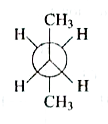 B
B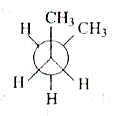 C
C D
D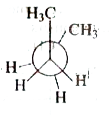
Conformations are different arrangements of atoms that are interconverted by rotation about single bond.
In eclipsed conformation, the C-H bond on-one carbon is directly aligned with C-H bond on the adjacent carbon.
In staggered conformation, the c H bond on one carbon biseçt, the H G H bond angle on adjacent carbon.
The angle that separates a bond on one atom from a bond on a adjacent atom is called a dihedral angle.
A staggered conformation with two larger groups 180∘ from each other is called anti. A staggered conformation with two larger group 60∘ from each other is called gauche.
Identify the most stable conformer of 2-fluoro, ethanol among the following:A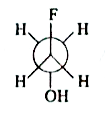 B
B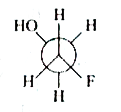 C
C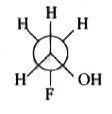 D
D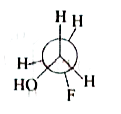
Conformations are different arrangements of atoms that are interconverted by rotation about single bond.
In eclipsed conformation, the C-H bond on-one carbon is directly aligned with C-H bond on the adjacent carbon.
In staggered conformation, the c H bond on one carbon biseçt, the H G H bond angle on adjacent carbon.
The angle that separates a bond on one atom from a bond on a adjacent atom is called a dihedral angle.
A staggered conformation with two larger groups 180∘ from each other is called anti. A staggered conformation with two larger group 60∘ from each other is called gauche.
Which of the following is gauche conformer?A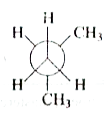 B
B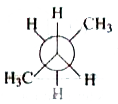 C
C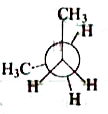 D
D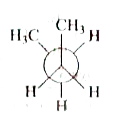
A magnetic needle free to rotate in a vertical plane parallel to the magnetic meridian has its north tip pointing down at 22∘ with the horizontal. The horizontal component of the earth's magnetic field at the place is known to be 0⋅35G. Determine the strength of the earth's magnetic field at the place.
View SolutionWith respect to graphite and diamond, which of the statements given below are correct?
(1) Graphite is harder than diamond.
(2) Graphite has higher electrical conductivity than diamond.
(3) Graphite has higher thermal conductivity than diamond.
(4)Graphite has higher C−C bond order than diamond.
View SolutionAllotropes of carbon: There are three forms of carbon. i.e., diamond, graphite and fullerene which exist in crystalline form. Graphite and diamond occur in nature. The structure of diamond is tetrahedral with sp3 hybridization and diamond exist in 3-D network solid. in graphite, carbon is sp2 hybridized. Each carbon linked to other carbon atom forms hexagonal ring. it has a layered structure. Diamond and graphite are purest form of carbon. Fullerene constitute a new family of carbon allotropes.
Consisting of large spheroidal molecule of compound with general formula C2n. common fullerene C6,C70, contain 5 and 6 membered rings.
Q. Which of the following statement is incorrect for graphite?
View SolutionA solid between A and B has the following arrangement of atoms :
(i) Atoms A are arranged in c.c.p. array.
(ii) Atoms B occupy all the all the octahedral voids and half the tetrahedral voids. What is the formula of the compound ?
View SolutionA solid between A and B has the following arrangement of atoms :
(i) Atoms A are arranged in c.c.p. array.
(ii) Atoms B occupy all the all the octahedral voids and half the tetrahedral voids. What is the formula of the compound ?
View Solution
